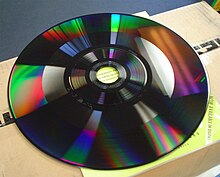Capacitance Electronic Disc

O Disco Eletrônico de Capacitância (CED) é um disco de vídeo analógico desenvolvido pela RCA, no qual o vídeo e o áudio poderiam ser tocados em um aparelho de TV usando uma agulha especial e um sulco de alta densidade similar a gravações de fonógrafo.
Planejado primeiro em 1964, o CED foi amplamente visto como um sucesso tecnológico que era capaz de ampliar a densidade de LPs em duas ordens de magnitude.[1] Porém, tornou-se vítima de mau planejamento, conflitos dentro da RCA, e dificuldades técnicas que atrasaram a produção do sistema por 17 anos (até 1981), quando já tinha sido tornado obsoleto pelo DiscoVision (LaserDisc), e pelos emergentes Betamax e VHS.
Desvantagens
[editar | editar código-fonte]Em comparação com o LaserDisc, os CEDs sofriam do fato de serem mídia de contato relacionada ao fonógrafo. A RCA estimava que os CEDs podiam ser tocados por 500 vezes, sob condições ideais.[2] Para comparar, um LaserDisc limpo e livre do "laser rot"(corrosão do disco a laser) poderia, teoricamente, ser tocado por infinitas vezes - apesar de que o manuseio ainda poderia resultar em dano. Dado que os sistemas de CED usavam uma agulha para ler os discos, era necessário trocá-la regularmente para evitar danos aos discos.
Ver também
[editar | editar código-fonte]Leitura adicional
[editar | editar código-fonte]- Cowie, Jefferson R. Capital Moves: RCA's Seventy-Year Quest for Cheap Labor. Ithaca, N.Y.: Cornell University Press, 1999. ISBN 0-8014-3525-0.
- Daynes, Rob and Beverly Butler. The VideoDisc Book: A Guide and Directory. New York: John Wiley and Sons, 1984. ISBN 0-471-80342-1.
- DeBloois, Michael L., ed. VideoDisc/Microcomputer Courseware Design. Englewood Cliffs, N.J.: Educational Technology Publications, 1982. ISBN 0-87778-183-4.
- Floyd, Steve, and Beth Floyd, eds. The Handbook of Interactive Video. White Plains, NY: Knowledge Industry Publications. 1982. ISBN 0-86729-019-6.
- Graham, Margaret B.W. RCA and the VideoDisc: The Business of Research. (Also as: The Business of Research: RCA and the VideoDisc.) Cambridge: Cambridge University Press, 1986. ISBN 0-521-32282-0, ISBN 0-521-36821-9.
- Haynes, George R. Opening Minds: The Evolution of Videodiscs & Interactive Learning. Dubuque, Iowa: Kendall/Hunt Publishing Co., 1989. ISBN 0-8403-5191-7.
- Howe, Tom. CED Magic: The RCA VideoDisc Collector's Guide. Portland, OR: CED Magic, 1999. ISBN 0-9670013-0-7. (CD-ROM)
- Isailovi´c, Jordan. VideoDisc and Optical Memory Systems. Englewood Cliffs, N.J.: Prentice-Hall, 1985. ISBN 0-13-942053-3.
- Lardner, James. Fast Forward: Hollywood, the Japanese, and the VCR Wars. (Also as: Fast Forward: Hollywood, the Japanese, and the Onslaught of the VCR.) New York: W. W. Norton & Co Inc., 1987. ISBN 0-393-02389-3.
- Lenk, John D. Complete Guide to Laser/VideoDisc Player Troubleshooting and Repair. Englewood Cliffs, N.J.: Prentice-Hall, 1985. ISBN 0-13-160813-4.
- Schneider, Edward W., and Junius L. Brennion. The Instructional Media Library: VideoDiscs, (Volume 16). Englewood Cliffs, NJ: Educational Technology Publications. ISBN 0-87778-176-1. 1981.
- Sigel, Efrem, Mark Schubin and Paul F. Merrill. Video Discs: The Technology, the Applications and the Future. White Plains, N.Y. : Knowledge Industry Publications, 1980. ISBN 0-914236-56-3. ISBN 0-442-27784-9.
- Sobel, Robert. RCA. New York: Stein and Day/Publishers, 1986. ISBN 0-8128-3084-9.
- Sonnenfeldt, Richard. Mehr als ein Leben (More than One Life). ?, 2003. ISBN 3-502-18680-4. (In German.)
- Journals:
- The Videodisc Monitor
- Videodisc News
- Videodisc/Optical Disk Magazine
- Video Computing
Referências
- ↑ «RCA SelectaVision VideoDisc FAQ - Why did the CED system fail to even come close to RCA's expected market penetration?». CEDMagic.com. Consultado em 11 de março de 2007
- ↑ «RCA SelectaVision VideoDisc FAQ - How long can I expect my CED VideoDiscs to last?». CEDMagic.com. Consultado em 14 de março de 2007